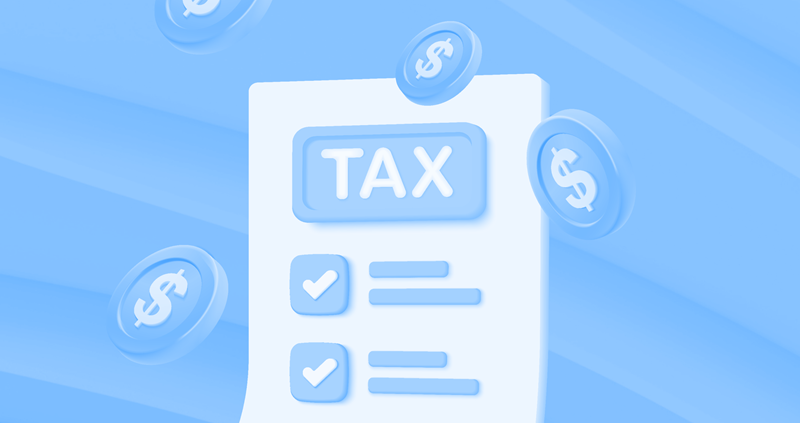Marginal vs. effective tax rates
How marginal vs. effective tax rates work, how they differ, and why both matter.
Marginal tax rate definition: The marginal tax rate is the rate applied to your last dollar earned, based on your highest tax bracket.
Effective tax rate definition: Effective tax rate is your average tax rate across all taxable income, and is usually lower than your marginal rate.
The importance of understanding both: Knowing both can help you plan smarter for raises, deductions, investments, and long-term savings strategies.
What is the marginal tax rate?
The marginal tax rate is the tax rate applied to your last dollar of income. The U.S. uses a progressive tax system, meaning chunks of your income are taxed at different rates rather than one flat rate across all of your taxable income. Essentially, your income is not taxed at a single rate but according to different brackets, and the marginal tax rate applies to your highest bracket.
2025 federal tax brackets
To understand how marginal tax rates work, you need to know what tax bracket you are in. The adjusted federal tax rates for tax year 2025, which will apply to tax returns to be filed starting in tax season 2026 are the following:1
Tax rate | Single filers | Head of household | Married couples filing jointly |
10% | $0 to $11,925 | $0 to $17,000 | $0 to $23,850 |
12% | $11,926 to $48,475 | $17,001 to $64,850 | $23,851 to $96,950 |
22% | $48,476 to $103,350 | $64,851 to $103,350 | $96,951 to $206,700 |
24% | $103,351 to $197,300 | $103,351 to $197,300 | $206,701 to $394,600 |
32% | $197,301 to $250,525 | $197,301 to $250,500 | $394,601 to $501,050 |
35% | $250,526 to $626,350 | $250,501 to $626,350 | $501,051 to $751,600 |
37% | Over $626,350 | Over $626,350 | Over $751,600 |
Standard deductions for tax year 2025 are as follows; $15,000 for single filers, $22,500 for heads of household, and $30,000 for married couples filing jointly.
How marginal tax rates are calculated
To help you better understand how marginal tax rates are calculated, let’s consider a theoretical example. Keep in mind that you will want to consider all of your taxable income when estimating your marginal tax rates.
Imagine you are a single taxpayer who earned a total gross income of $85,000 in 2025 and a total taxable income of $70,000, after standard deductions. Using the chart above, you can see that your income puts you in the 22% tax bracket.
Estimating your marginal tax rates with a total taxable income of $70,000 (after deductions) would look like this:
Tax rate | Taxable income for single filers | Taxes owed per marginal tax bracket (bracket's taxable income × bracket's tax rate) |
10% | $0 to $11,925 | $11,925 × 10% = $1,192.50 |
12% | > $11,925 to $48,475 | ($48,475 - $11,925) × 12% = $4,386 |
22% | > $48,475 to $103,350 | ($70,000 - $48,475) × 22% = $4,735.50 |
Total taxes owed: $10,314
This example shows you how even though you fell into the 22% tax bracket, that rate did not apply to your total income, but rather just a portion of it. In this case, your marginal tax rate was 22%, since that was your top bracket.
What is the effective tax rate?
Your effective tax rate, on the other hand, tells you what percentage of your income you paid to the IRS. The effective tax rate is the average rate of federal income tax paid on total taxable income, or your total tax liability divided by your total taxable income.
Effective tax rates can give you a more accurate representation of your tax liability for the year, and because it is an average of the taxes you pay rather than the highest rate you pay, your effective tax rate should be lower than the marginal tax rate.
However, the effective tax rate does not give you the full picture of all the taxes you paid, since it only gives you the percentage you paid in federal income taxes relative to your taxable income, but oftentimes you may end up paying additional taxes (e.g., state and local taxes, sales taxes, or property taxes).
How effective tax rates are calculated
Calculating your effective tax rate can be more straightforward compared to calculating your marginal tax rate. You simply need to divide your total tax liability (the amount you owe the IRS) by your taxable income, multiply that number by 100, and that’s your effective tax rate. Some analysts use AGI or total income as the divisor in this calculation, so definitions may vary. This equates to the percentage of your income that you paid in taxes.
One of the simplest ways to find this is by using your Form 1040. There you will find your total tax (line 24) and taxable income (line 15).
To find your effective tax rate would look something like this:
Form 1040: total tax (line 24) ÷ taxable income (line 15) × 100% = effective tax rate
For example, if we use the example from above where you had a total taxable income of $70,000 in 2025 with a total tax liability of $10,314 would give you an effective tax rate of ≈ 14.7%
$10,314 (total tax) ÷ $70,000 (total taxable income) x 100 = 14.7% (effective tax rate)
Marginal vs. effective tax rates: How they differ
While both are similar concepts, it’s important to understand the differences between marginal and effective tax rates and what they are used for.
Here is a side-by-side comparison of marginal vs. effective tax rates to help you get a clearer picture:
Feature | Marginal Tax Rate | Effective Tax Rate |
Definition | The rate applied to your last dollar of taxable income (based on your tax bracket). | The average rate you pay on your total income (total tax ÷ total income). |
Purpose | Shows how much tax you’ll owe on additional income (e.g., from a raise or bonus). | Shows your true overall tax burden as a percentage of income. |
How it works | Income is taxed progressively, with higher portions taxed at higher rates. | Blends all the rates across brackets into one overall (effective) percentage. |
Example (Single filer, $70,000 taxable income in 2025) | Marginal rate: 22% (because income falls into the 22% bracket). | Effective rate: 14.7% |
Use case | Helpful for tax planning when considering raises, bonuses, or deductions. | Helpful for budgeting and understanding how much of your income goes to taxes. |
Typical magnitude | Typically the top bracket (e.g. 22%, 32%, etc.) | Typically lower (e.g. 10-20% range, depending on deductions) |
In short: Marginal tax rate = tax on your last dollar; Effective tax rate = average tax across all dollars.
Why understanding marginal vs. effective tax rates matters
Understanding the difference between marginal and effective tax rates is essential for several reasons, including:
Reducing your marginal tax rate: If you know your marginal tax rate, you can better understand potential tax savings from deductions or retirement plan contributions. Tax strategies like contributing to a traditional IRA or 401(k), using HSA contributions, or itemizing charitable donations or medical expenses can help ease your tax burden.
Lowering your effective tax rate: Knowing your effective tax rate allows you to better estimate how much of your income will go towards taxes. Claiming standard or itemized deductions smartly, using tax credits (e.g., child tax credit, education, or savers credit), and using tax‑efficient investment vehicles and long‑term capital gains timing can help you potentially reduce your effective tax rate.
Budgeting and saving: Knowing your marginal and effective tax rates can help you have a clearer picture of your overall tax burden, which can be particularly helpful for budgeting and saving. Your estimated effective tax rate can give you a better overview of how much of your income will go towards taxes and how much you have left for saving or other expenses.
If you're planning a budget and wondering how to make the most of your after-tax dollars, the Raisin marketplace gives you access to a variety of high-yield savings products. Explore account types, compare interest rates, and start growing your savings today!
Financial planning: Understanding your marginal and effective tax rate can also help you make more informed decisions on earning additional income from a side gig. It can also help you choose your investments wisely and help you better estimate how much of your investment income you will keep after taxes.
Bottom line
Marginal and effective tax rates measure two different, but equally important, aspects of your tax liability. Your marginal rate helps you anticipate the impact of extra income or deductions, while your effective rate shows your true tax burden. Understanding both gives you the tools to budget effectively, save strategically, and negotiate income or investment decisions with confidence.
If you want to increase your savings potential, Raisin is here to help. The Raisin marketplace gives you access to multiple high-yield savings products with competitive interest rates to help grow your savings. Discover account types, compare interest rates, and sign up today to start maximizing your savings potential!
FAQs on marginal vs. effective tax rates
How do state taxes affect my effective tax rate?
State and local taxes add to your overall tax liability, so while your federal effective tax rate only reflects federal income taxes, your true effective tax rate could be higher once you include state, local, property, or sales taxes.
Can my marginal and effective tax rates be the same?
In most cases, no. Your marginal rate only applies to the last portion of income, while your effective rate averages all brackets. They would only be the same if all your taxable income fell entirely within one bracket.
What deductions count toward lowering effective vs marginal rates?
Deductions (like retirement contributions, mortgage interest, or charitable donations) reduce your taxable income, which can lower both your effective rate (average) and sometimes your marginal rate if deductions move you into a lower tax bracket.
Should I pay attention to marginal rate or effective rate when negotiating a raise?
Your marginal rate matters more for raises, since it tells you how much of each additional dollar will be taxed. Your effective rate matters for overall budgeting, since it shows your total tax burden relative to your income.
The above article is intended to provide generalized financial information designed to educate a broad segment of the public; it does not give personalized tax, investment, legal, or other business and professional advice. Before taking any action, you should always seek the assistance of a professional who knows your particular situation for advice on taxes, your investments, the law, or any other business and professional matters that affect you and/or your business.


